
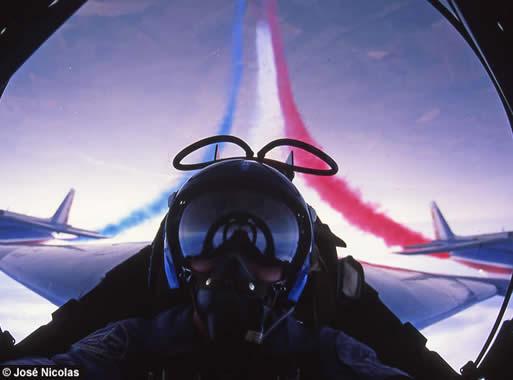
In May 2013, the Patrouille de France celebrated its 60th anniversary. More than sixty years of panache, dreams and passion, during which the acrobatic flying team has crossed the skies throughout the world, arousing the admiration and enthusiasm of thousands of spectators. Behind the magic of their performance lies a strict and exacting training of the pilots and exceptional technical competence on the part of the whole personnel of the Patrouille de France.
Created in 1953 and based in Salon de Provence, the Patrouille de France is the oldest military acrobatic flight team of all time. For 55 years, it has enchanted the entire public, in France and abroad, especially since 1981, date when it was equipped with the new Franco-German plane, the Alpha Jet.
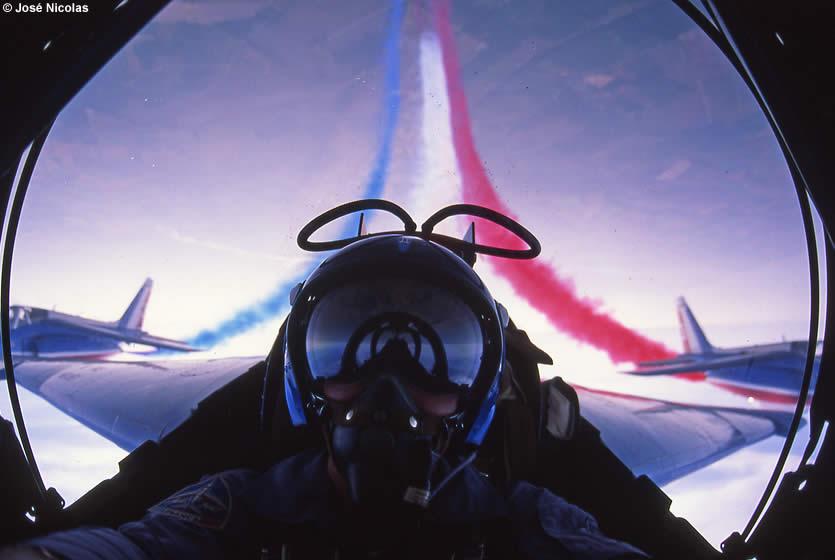
Pilot in the cockpit
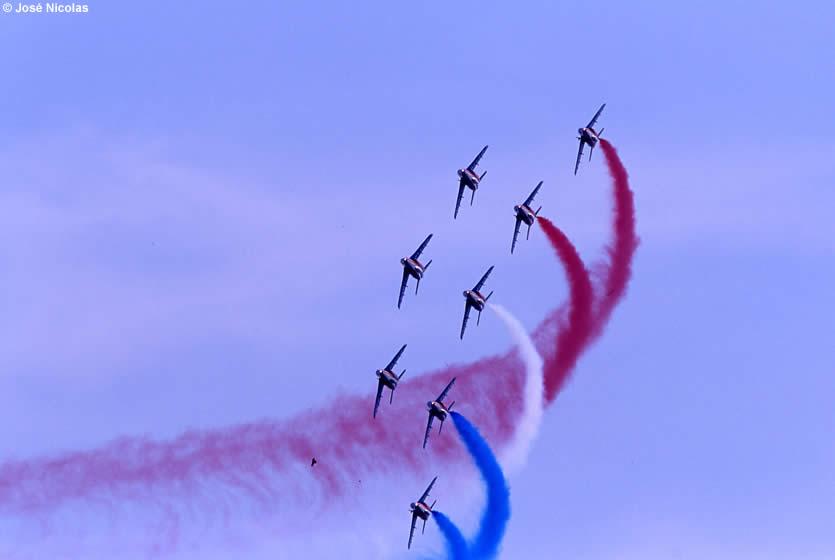
Duck formation
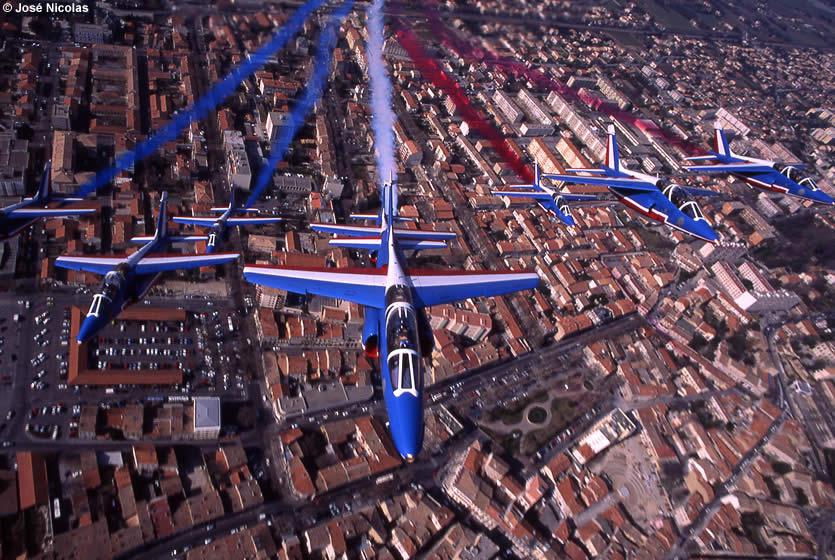
The Patrouille de France flying over Salon de Provence
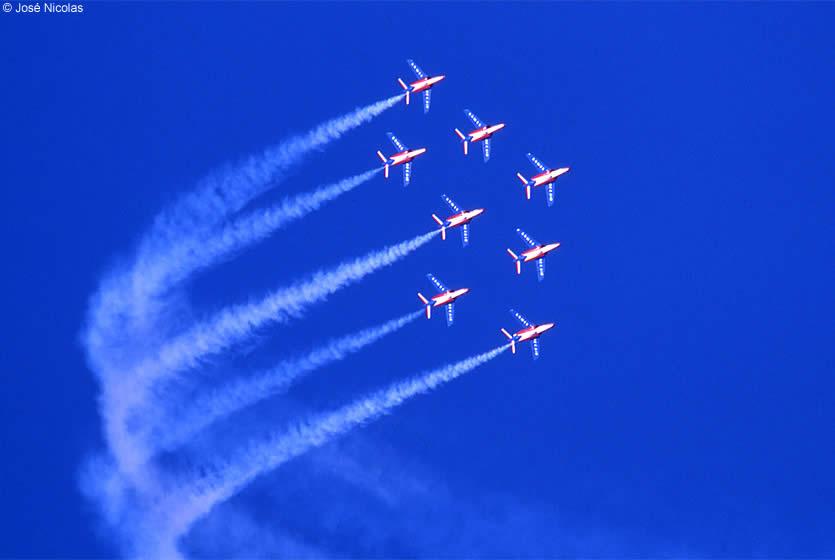
Diamond formation
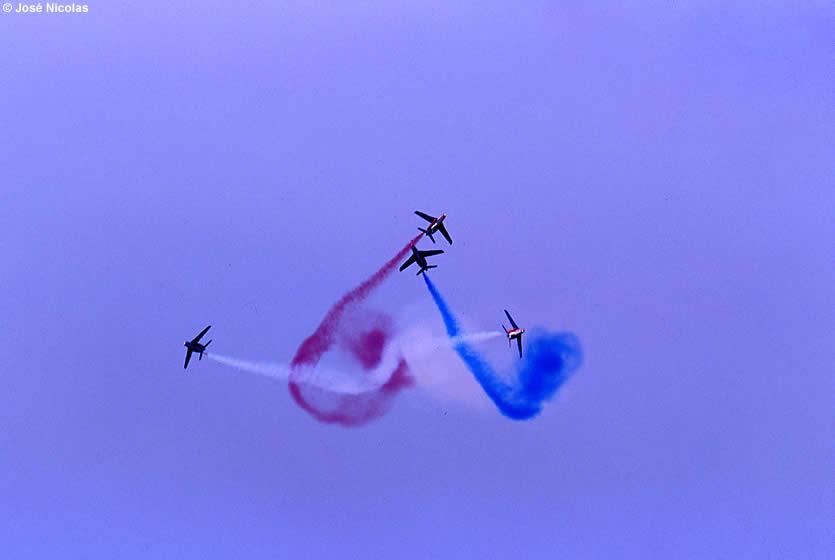
The "Blue White Red" heart of the Patrouille de France
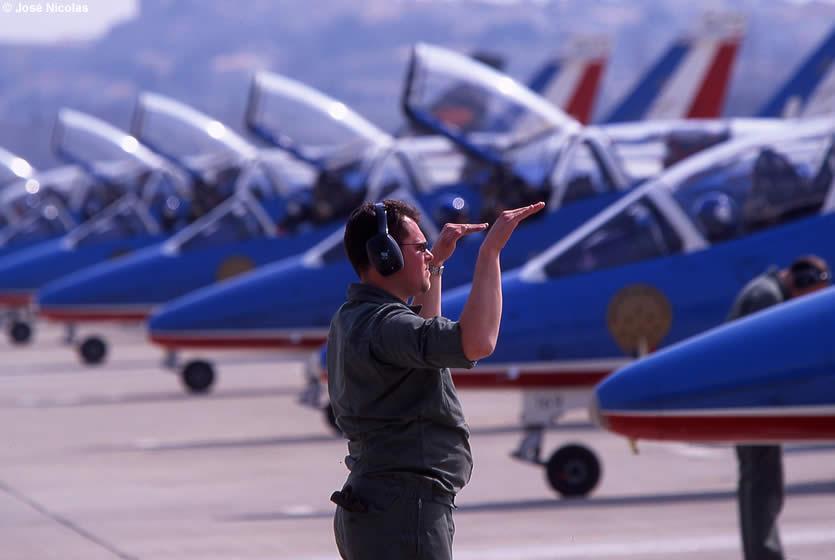
Preparations for the take-off
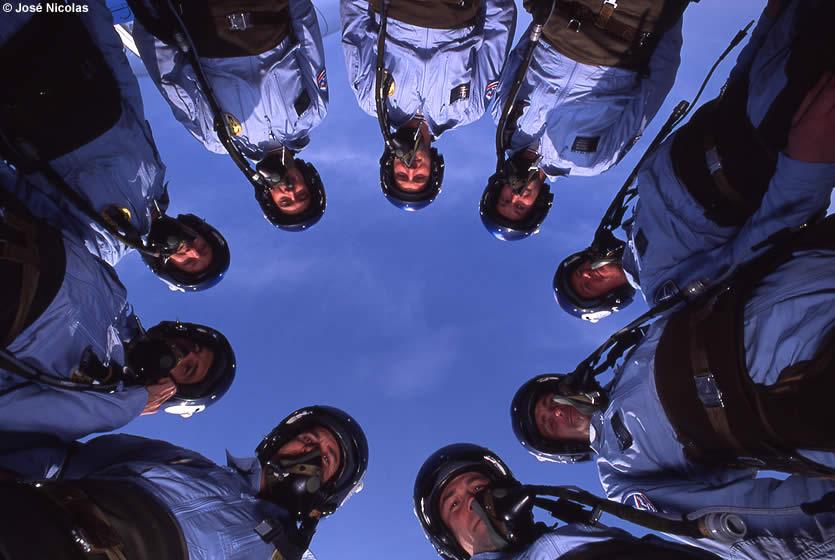
The pilots of the Patrouille de France
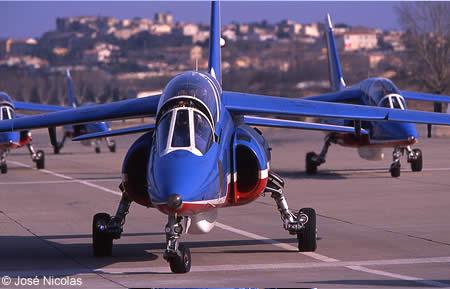
Twin-engine jet with high-site arrow wings and tandem two-seater, the AlphaJet is powered by two Larzac 04 bypass turbofans, each developing 1320 daN. 11.85 meters long and 4.19 meters high, the AlphaJet can weigh upon take-off 7250 kgs maximum. This small, high-performance twin engine, which has a take-off distance of 700 meters and reaches Mach 0.86 at 15,000 meters, is very representative of combat planes used by many air forces, where its flight qualities, manoeuvrability and safety are highly appreciated.
The Alphajet has not been specially modified for the Patrouille de France, except for the paint, which is blue-white-red, the nose light, the sights, which have been removed as they are of no use, and finally the smoke-producing pod fixed to the belly replacing the cannon pod, letting them leave in the sky plumes of blue, white or red smoke. Diamond, lozenge, duck, T, concord, arrow, large arrow and very large arrow are some of the impressive figures that the AlphaJets of the Patrouille de France make.
Such a performance leaves no room for improvisation
The positions of the eight planes are extremely precise. From the "leader", the formation's conductor, to the "vulture", which follows it, without forgetting the "insides", the "outsides" and the "solos", each knows perfectly its place and role. Before offering the public a smoothly run performance where everything seems so easy, hours and hours of work are necessary. Each year, six months of training allow them to organize the new show. Training that respects, day after day, the same programme, from 8am to 5:30pm: body building, briefing, first flight, debriefing and correction of mistakes, briefing, 2nd flight, lunch, debriefing, group sports. Discipline necessary to build and perfect the intricate, three-dimensional puzzle that is the performance.
Each figure, after being conceived and meticulously analyzed on the ground, is then carried out in flight in the basic, diamond formation. When it has been well assimilated by all, they add changes to the formation, then later, white or coloured smoke. Then they string the different figures together, slowly but surely, to give birth to the series. Piloting with the Patrouille de France is an extension of the skills acquired in operational units, to which thy must add the specificity of this particular profession : tight squadron flying at very low altitude. The planes move at speeds between 200 and 600 kms/hour and are approximately two meters apart during the flights, subjecting the pilots to accelerations between -3G et +7G, at a height between 30 and 1500 meters off the ground. It is very hard physically, and even more so psychologically.
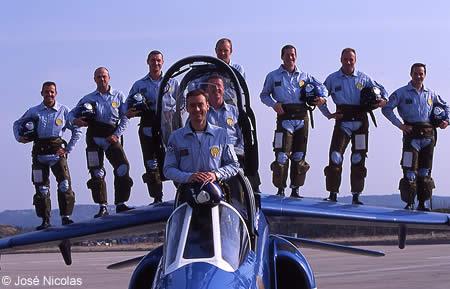
While piloting practically wing to wing at 600 kilometers an hour, without any other visual bearing than the leader's plane, the pilots know that the slightest error is synonymous with fatal accident. That's why the pilots are assigned to the Patrouille de France for a duration of only three years. Each year, three new pilots join the Patrouille de France, and the three "oldest" leave. Three new positions that are highly coveted : many are they who want to pilot a blue-white-red Alpha Jet, but few are chosen. The candidates for the positions are volunteer officers, coming from the different combat units of the French Air Force. They are squadron leader pilots, the highest qualification in a fighter squadron, some in Jaguars, others in the Mirage F1 or Mirage 2000. They have a minimum experience of 1500 hours of jet flying. The selection operates on several levels. After having obtained the backing of the hierarchy and been chosen by headquarters, the candidates present themselves to the Patrouille de France and are designated by their peers, following the principle of co-optation. This last selection is more subjective as it is essentially founded on the candidates' character and sociability, but it is primordial : the harmony amongst all the team's members is vital for the group's coherence and stability. Virginie Guyot, the first woman to join the Patrouille de France, occupied the position of leader in 2009, a world first.
Another vital element for the show's success is the technical team. Each pilot has his assigned mechanic with about twenty other mechanics and a troubleshooting team assisting them. One hour of flight in an Alpha Jet demands ten hours of preparation: verification of the turbojet, washing the cockpit windows, maintenance of the indispensable ejection seat... The trust between ?flyers? and ground crew is so strong that no pilot would affront his mechanic by going to inspect the plane before take-off. Before climbing aboard the planes, the pilots participate in the ?mass?, the briefing that takes place before each flight.
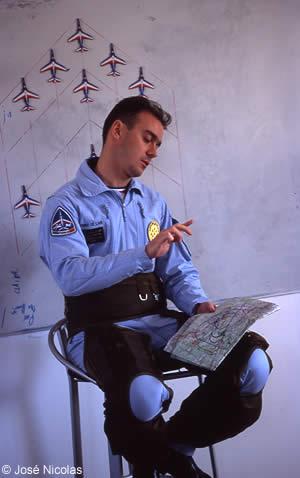
Hands joined on his knees, facing his men, the squadron leader of the Patrouille de France stares into the space before him and begins a curious litany : "And 10 on the radio... We'll roll to the right... duck formation... turn to the left... take some some trim, smoke... Set, intermediate break-up, the outsides... Set" This monologue, the "music" that the pilots know by heart, is the last general and mental rehearsal for what they will carry out in flight in a few moments.
Eyes closed to better concentrate,the pilots have all mimed the movements to come. Still a few minutes to go then the patrol takes off, soaring in groups of four. After a first veer to the left, it takes on the diamond formation, and then starts nearly an hour of show, a sequence of the most audacious acrobatics : looping, flying upside down, vertiginous dives, up to the crowning finale in the form of a blue-white-red heart. A fluid and well-knit show will be presented fifty times between May and September, everywhere in France but also in Europe, Africa and Russia. A magical show that the Patrouille de France puts itself through, the oldest and most prestigious aerobatics on the planet.
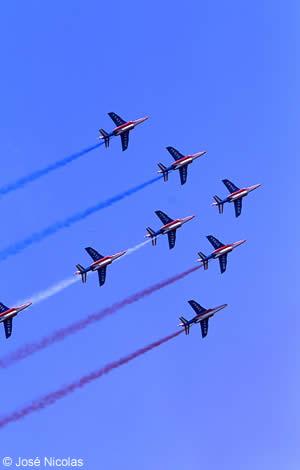
The Patrouille de France's programme changes each year. Each programme (determined by the squadron leader at the start of the season) is one of a kind because of the order of the figures and the use of different formations. The emblematic figure of the Patrouille de France is the heart (a scale in Y with six planes cut by an arrow of smoke from the two solos). The movements of the Patrouille de France are done in formation, which means that the eight planes fly very close to one another (2 to 3 meters). These formations have very special names that are often references or veiled allusions.
Alpha : The 8 planes form a motif made up of three circumflexes forming the Greek letter Alpha.
Ariane : The leader, the vulture and the solos form a vertical line. On either side of the second solo (who brings up the rear), the insides and the outsides form vertical lines of two planes, the whole resembles a two-beam formation staggered towards the back and evoking the form of the Ariane 4.
Duck : The leader and the insides form an arrow of three; behind them the vulture, the outsides and the solos form a second arrow interwoven into the other forming a chevron.
Concorde : Starting with the diamond formation, the leader and the vulture move forward. The vulture takes the place of the leader who finds himself at the head. The whole takes on the shape of the Concorde.
Crossbar : The leader, the vulture and the solos form a vertical line. Between the vulture and the solo leader, the insides and the outsides come place themselves in a horizontal line forming a cross.
Big Nine : This is a formation where the leader is at the head, the insides on either side slightly trailing. The outsides places themselves on either side of the insides. The vulture and the reserve complete, in the same manner, the formation, the whole forming a chevron of nine planes (formation used for the July 14 parade).
Wind gust : The leader and the vulture are at the head, the insides and the outsides form a first horizontal line behind the vulture. The solos form another horizontal line at the back.
Arrow : The leader, the insides and the outsides form a pyramid. The other team members led by the vulture form a vertical line behind the leader.
Large Arrow : The leader at the head, the vulture behind him, the insides on either side of and slightly trailing the leader, the outsides are themselves trailing the insides on either side.
Very Large Arrow : Starting with a large arrow formation the leader and the vulture move forward by a space.
Scale : The leader is at the head, the vulture still behind him. The outsides and the insides line themselves up in a horizontal line between the leader and the solos.
Super Scale : Like the scale, only in that the solos are to the outside of the formation on the horizontal line.
Apollo : The leader and the vulture are at the head. Behind the vulture, on either side, are the two insides. The outsides places themselves behind the insides in the same formation. The two solos are staggered on either side of the outsides the whole evoking the shape of the lunar module of the Apollo missions.
Rocket : Starting with a crossbar formation the outsides fall behind to arrive level with the second solo.
Diamond : The planes take up position in a tight pyramidal box following the 1-2-3-2 model. The whole forms a diamond.
T : The leader, the insides and the outsides form a horizontal line. The other team members led by the vulture form a line vertical behind the leader.
Spear : This is a crossbar formation in which the outsides fall behind to arrive level with the solo leader.
Transall : The leader is still at the head with the vulture behind him. Between the two the insides and the outsides form a straight line. The two solos are next to each other behind the vulture.
Swan : Starting with a large arrow formation with six planes led by the solo leader, the vulture places himself in front of the solo leader. The leader leads the whole formation from in front of the vulture.
Two beams : The leader and the vulture are at the head ; the insides and the outsides form two "beams" of three planes (vertical alignment) on either side of the vulture.
Lozenge : Starting with a diamond formation, then the vulture falls back to situate himself behind the solos.
Patrouille de France - Base Aérienne 701 - 13661 Salon Air
+33 (0)4 90 17 83 38
http://www.patrouilledefrance.frOther accommodations
Vacation rentalWhere to sleep?